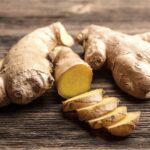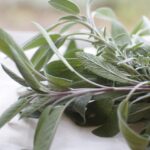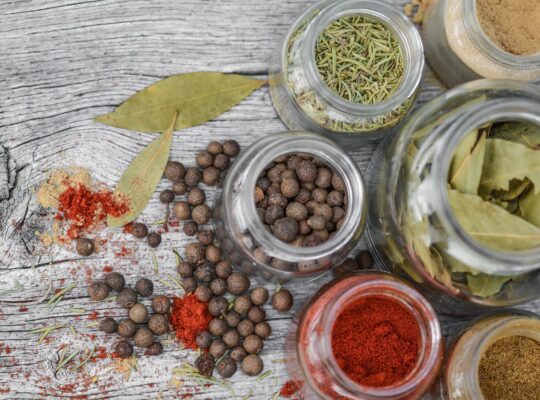
In this herbs and spices spotlight, we’ll explore the popular “king of spices” – black pepper As we continue with HOLISTICALLY SPEAKING, today we will spotlight BLACK PEPPER as our third culinary spice for National Nutrition Month. Sometimes called black peppercorn, piper, or pepper for short, More also known as black peppercorn, pepper, and piper. Derived from an Indian name, its “genus name comes from the Latin name from the Greek word peperi” (missouribotanicalgarden.org). Furthermore, “the word pepper comes from the Sanskrit pippali, meaning “berry” (Franklin, 2o19). Per the Healing Spices Handbook by Barbara Grogan (2020), the herbal actions/medicinal for black pepper
As we continue with HOLISTICALLY SPEAKING, today we will spotlight BLACK PEPPER as our third culinary spice for National Nutrition Month. Sometimes called black peppercorn, piper, or pepper for short, More also known as black peppercorn, pepper, and piper. Derived from an Indian name, its “genus name comes from the Latin name from the Greek word peperi” (missouribotanicalgarden.org). Furthermore, “the word pepper comes from the Sanskrit pippali, meaning “berry” (Franklin, 2o19). Per the Healing Spices Handbook by Barbara Grogan (2020), the herbal actions/medicinal for black pepper As we continue with HOLISTICALLY SPEAKING, today we will spotlight BLACK PEPPER as our third culinary spice for National Nutrition Month. Sometimes called black peppercorn, piper, or pepper for short, More covers a wide range, such as:
As we continue with HOLISTICALLY SPEAKING, today we will spotlight BLACK PEPPER as our third culinary spice for National Nutrition Month. Sometimes called black peppercorn, piper, or pepper for short, More covers a wide range, such as:
- Antibacterial
- Anti-inflammatory
- Antioxidant
- Anti-spasmodic
- Carminative
- Cardiovascular health
- Decongestant
- Digestive
- Expectorant
- Hypoglycemic
- Immune modulator/stimulant
- Liver stimulant
Actually, black peppercorn – along with green, white, and red peppercorn – all come from the unripe berries of the Piper nignum. The Piper nignum “is a tropical plant that produces the popular black and white peppercorns…native to southern India and Sri Lanka. [It is traditionally] used in Indian cooking since at least 2000 B. C.” (missouribotanicalgarden.org).
Per the 3rd edition of Encyclopedia of Herbal Medicine (2016): “Native to southwestern India, pepper is now cultivated in tropical areas around the world. The fruit is harvested from plants that are at least 3 years old. Green peppercorns are picked unripe and pickled, black peppercorns are picked unripe and dried, red peppercorns are picked ripe and dried, and white peppercorns are picked ripe and soaked in water for 8 days before drying” (p. 250).
The active component of black pepper As we continue with HOLISTICALLY SPEAKING, today we will spotlight BLACK PEPPER as our third culinary spice for National Nutrition Month. Sometimes called black peppercorn, piper, or pepper for short, More – what gives it its flavor and its tick – is piperine, which is the primary reason it’s considered a warming carminative/spice. In general, “carminatives tend to be warming [as] they’re a nice complement to ‘cold’ digestive bitters….” However, it’s advised that one should “go easy on them with ‘hot’ GI issues including inflammation and tissue damage.” (Groves, 2016) In addition, carminatives “encourage good gut flora while inhibiting pathogens” [and thus are] primary herbs for indigestion, gas, pain, bloating, colic, IBS, and intentional cramps and supportive herbs alongside [digestive] bitters and in herbal blends to heal the gut or address diarrhea/constipation, IBD, or dysbiosis.” (Grove, 2016)
As we continue with HOLISTICALLY SPEAKING, today we will spotlight BLACK PEPPER as our third culinary spice for National Nutrition Month. Sometimes called black peppercorn, piper, or pepper for short, More – what gives it its flavor and its tick – is piperine, which is the primary reason it’s considered a warming carminative/spice. In general, “carminatives tend to be warming [as] they’re a nice complement to ‘cold’ digestive bitters….” However, it’s advised that one should “go easy on them with ‘hot’ GI issues including inflammation and tissue damage.” (Groves, 2016) In addition, carminatives “encourage good gut flora while inhibiting pathogens” [and thus are] primary herbs for indigestion, gas, pain, bloating, colic, IBS, and intentional cramps and supportive herbs alongside [digestive] bitters and in herbal blends to heal the gut or address diarrhea/constipation, IBD, or dysbiosis.” (Grove, 2016)
Black Pepper for Digestion:
Per Body in Balance: An Herbal Guide to HolisticA healing approach that looks at the whole person and not just their physical symptoms, in order to eradicate illness and produce well-being in the mind, body, and soul. Self-Care by Marie Groves (2016): “An unbalanced digestive system will often produce gas, pain and bloating” (Groves, 2016, p. 80). Symptoms, diseases, and disorders of an unbalanced digestive system include “dysbiosis (lack of beneficial bacteria and/or influx of bad bacteria/yeast), poor diet, stress, food allergies/sensitivities, and physical damage to the gut (from celiac disease, inflammatory bowel disease, diverticulitis, leaky gut).” (Groves, 2016) “Pepper is…to improve digestive function in cases of nausea, stomachache, flatulence, bloating, constipation, or lack of appetite.” (Chevallier, 2016, p. 250). It boosts the metabolism and thus can help in weight loss as it relates to obesity (Franklin, 2019).
Metaphysically Speaking:
Per The Hearth Witch’s Kitchen Herbal by Anna Franklin (2019), in Hindi tradition, black pepper As we continue with HOLISTICALLY SPEAKING, today we will spotlight BLACK PEPPER as our third culinary spice for National Nutrition Month. Sometimes called black peppercorn, piper, or pepper for short, More is linked with the sun or solar energy, which is associated with the root chakra"Wheel" or "Vortex" - describes an energy center in the human energy field. Although there are hundreds of chakras, there are seven main chakras commonly taught in the Western world:, which grounds, stabilizes, and balances.* “In some traditions, black pepper
As we continue with HOLISTICALLY SPEAKING, today we will spotlight BLACK PEPPER as our third culinary spice for National Nutrition Month. Sometimes called black peppercorn, piper, or pepper for short, More is linked with the sun or solar energy, which is associated with the root chakra"Wheel" or "Vortex" - describes an energy center in the human energy field. Although there are hundreds of chakras, there are seven main chakras commonly taught in the Western world:, which grounds, stabilizes, and balances.* “In some traditions, black pepper As we continue with HOLISTICALLY SPEAKING, today we will spotlight BLACK PEPPER as our third culinary spice for National Nutrition Month. Sometimes called black peppercorn, piper, or pepper for short, More is used to combat spirit possession. Islamic exorcists use ingredients like lime, vinegar, black pepper
As we continue with HOLISTICALLY SPEAKING, today we will spotlight BLACK PEPPER as our third culinary spice for National Nutrition Month. Sometimes called black peppercorn, piper, or pepper for short, More is used to combat spirit possession. Islamic exorcists use ingredients like lime, vinegar, black pepper As we continue with HOLISTICALLY SPEAKING, today we will spotlight BLACK PEPPER as our third culinary spice for National Nutrition Month. Sometimes called black peppercorn, piper, or pepper for short, More, and ginger
As we continue with HOLISTICALLY SPEAKING, today we will spotlight BLACK PEPPER as our third culinary spice for National Nutrition Month. Sometimes called black peppercorn, piper, or pepper for short, More, and ginger I love Ginger so much that my go-to for battling mild digestive discomforts. With that said, it dispels gas and relieves nausea, motion sickness, seasickness, and sore throats. It's also More, which are thought to burn jinn (spirits), in conjunction with prayers to drive jinni from a victim’s body. You can add black pepper
I love Ginger so much that my go-to for battling mild digestive discomforts. With that said, it dispels gas and relieves nausea, motion sickness, seasickness, and sore throats. It's also More, which are thought to burn jinn (spirits), in conjunction with prayers to drive jinni from a victim’s body. You can add black pepper As we continue with HOLISTICALLY SPEAKING, today we will spotlight BLACK PEPPER as our third culinary spice for National Nutrition Month. Sometimes called black peppercorn, piper, or pepper for short, More to incense used for exorcism and banishing or combine with salt and sprinkle it around boundaries to prevent the psychic attack and dispel negative influences. Combine with dried sage
As we continue with HOLISTICALLY SPEAKING, today we will spotlight BLACK PEPPER as our third culinary spice for National Nutrition Month. Sometimes called black peppercorn, piper, or pepper for short, More to incense used for exorcism and banishing or combine with salt and sprinkle it around boundaries to prevent the psychic attack and dispel negative influences. Combine with dried sage More commonly known for its use by Native Americans as a "herb of purification...used for the cleansing of the mind, body, and spirit as well as sacred articles before prayers More and burn as incense to remove bad energies from a new home or office” (p. 46).
More commonly known for its use by Native Americans as a "herb of purification...used for the cleansing of the mind, body, and spirit as well as sacred articles before prayers More and burn as incense to remove bad energies from a new home or office” (p. 46).
Drug Interactions & Other Uses:
Per the American Herbal Products Association’s Botanical Safety Handbook (2nd ed.), there are no known contraindications or other precautions with pepper although studies continued to be conducted. Studies have continuously shown that pipeline increases the bioavailability of certain drugs thus enhancing their therapeutic benefits. “Some studies have indicated that coadministration of pipeline with certain drugs allowed for a reduction in the required dose of the drugs.” (AHPA, p. 663)
Research shows it “inhibits an enzyme that breaks down the calming neurotransmitter serotonin, thus make it useful for treating mood disorders.” “The standard dose of pipeline used in human studies is 20 mg daily, though one study measured a delay in the elimination of phenytoin in human subjects fed soup with black pepper As we continue with HOLISTICALLY SPEAKING, today we will spotlight BLACK PEPPER as our third culinary spice for National Nutrition Month. Sometimes called black peppercorn, piper, or pepper for short, More.” Aside from aiding in the digestive process: [It is also known as “a ‘head ‘herb’, clearing congestion and acting as an expectorant…it also supports enzymes in the liver that help metabolize medications for heart disease, arthritis, and epilepsy.”
As we continue with HOLISTICALLY SPEAKING, today we will spotlight BLACK PEPPER as our third culinary spice for National Nutrition Month. Sometimes called black peppercorn, piper, or pepper for short, More.” Aside from aiding in the digestive process: [It is also known as “a ‘head ‘herb’, clearing congestion and acting as an expectorant…it also supports enzymes in the liver that help metabolize medications for heart disease, arthritis, and epilepsy.”
Unfortunately, excessive consumption of black pepper As we continue with HOLISTICALLY SPEAKING, today we will spotlight BLACK PEPPER as our third culinary spice for National Nutrition Month. Sometimes called black peppercorn, piper, or pepper for short, More (say in large doses as a supplement) can cause “gastrointestinal irritation in some people” (Easley & Horne, 2016, p. 186). This is emphasized by AHPA: “Large doses of pepper may irritate the urinary tract. Overdoses of pepper may cause abdominal heat and burning, thirst, vomiting, fever and sometimes convulsions.” In general, a low dosage is often associated with using black pepper
As we continue with HOLISTICALLY SPEAKING, today we will spotlight BLACK PEPPER as our third culinary spice for National Nutrition Month. Sometimes called black peppercorn, piper, or pepper for short, More (say in large doses as a supplement) can cause “gastrointestinal irritation in some people” (Easley & Horne, 2016, p. 186). This is emphasized by AHPA: “Large doses of pepper may irritate the urinary tract. Overdoses of pepper may cause abdominal heat and burning, thirst, vomiting, fever and sometimes convulsions.” In general, a low dosage is often associated with using black pepper As we continue with HOLISTICALLY SPEAKING, today we will spotlight BLACK PEPPER as our third culinary spice for National Nutrition Month. Sometimes called black peppercorn, piper, or pepper for short, More as a cooking spice. Taking it as a supplement increases one’s chances of consuming or absorbing it in large than normal amounts.
As we continue with HOLISTICALLY SPEAKING, today we will spotlight BLACK PEPPER as our third culinary spice for National Nutrition Month. Sometimes called black peppercorn, piper, or pepper for short, More as a cooking spice. Taking it as a supplement increases one’s chances of consuming or absorbing it in large than normal amounts.
Herbal Methods & Dosage:
Black Pepper As we continue with HOLISTICALLY SPEAKING, today we will spotlight BLACK PEPPER as our third culinary spice for National Nutrition Month. Sometimes called black peppercorn, piper, or pepper for short, More can be taken internally as a traditional seasoning or spice sprinkled onto food or as a beverage – think black pepper
As we continue with HOLISTICALLY SPEAKING, today we will spotlight BLACK PEPPER as our third culinary spice for National Nutrition Month. Sometimes called black peppercorn, piper, or pepper for short, More can be taken internally as a traditional seasoning or spice sprinkled onto food or as a beverage – think black pepper As we continue with HOLISTICALLY SPEAKING, today we will spotlight BLACK PEPPER as our third culinary spice for National Nutrition Month. Sometimes called black peppercorn, piper, or pepper for short, More milk for congestion, or as a tincture or capsule. Externally, black pepper
As we continue with HOLISTICALLY SPEAKING, today we will spotlight BLACK PEPPER as our third culinary spice for National Nutrition Month. Sometimes called black peppercorn, piper, or pepper for short, More milk for congestion, or as a tincture or capsule. Externally, black pepper As we continue with HOLISTICALLY SPEAKING, today we will spotlight BLACK PEPPER as our third culinary spice for National Nutrition Month. Sometimes called black peppercorn, piper, or pepper for short, More can be beneficial as an essential oil as in its use for craving smoking addiction (when sniffed on a cotton ball). Topically, as a compress for treating nerve (and ankle) pain, as an exfoliating skin scrub for dry skin relief – but performed sparingly as not to irritate the skin. It can also be applied as a skin paste when mixed with turmeric
As we continue with HOLISTICALLY SPEAKING, today we will spotlight BLACK PEPPER as our third culinary spice for National Nutrition Month. Sometimes called black peppercorn, piper, or pepper for short, More can be beneficial as an essential oil as in its use for craving smoking addiction (when sniffed on a cotton ball). Topically, as a compress for treating nerve (and ankle) pain, as an exfoliating skin scrub for dry skin relief – but performed sparingly as not to irritate the skin. It can also be applied as a skin paste when mixed with turmeric This sunshine-yellow root has become an everyday staple in the fresh produce section of even traditional supermarkets. Packed with Vitamins C and E, Turmeric works wonders to enhance immunity. For More for relief with shingles. Recommended dosages are as follows:
This sunshine-yellow root has become an everyday staple in the fresh produce section of even traditional supermarkets. Packed with Vitamins C and E, Turmeric works wonders to enhance immunity. For More for relief with shingles. Recommended dosages are as follows:
- Culinary: As a spice, sprinkle on meals as desired. (Always grind to release flavors.)
- WHERE TO BUY: Black Peppercorns Whole, Organic, 1/2 lb. (India) via Bulk Herb Store** ($11.95)
- Tincture: Dried fruit (1:5. 50% alcohol); 1-2 ml (0.2-0.4 tsp.) 3x daily.
- WHERE TO BUY: Visit LifeIRL.com here for a variety of black pepper
 As we continue with HOLISTICALLY SPEAKING, today we will spotlight BLACK PEPPER as our third culinary spice for National Nutrition Month. Sometimes called black peppercorn, piper, or pepper for short, More tincture options – some of which are alcohol-free.
As we continue with HOLISTICALLY SPEAKING, today we will spotlight BLACK PEPPER as our third culinary spice for National Nutrition Month. Sometimes called black peppercorn, piper, or pepper for short, More tincture options – some of which are alcohol-free.
- WHERE TO BUY: Visit LifeIRL.com here for a variety of black pepper
- Capsule: 10 mg piperine extract 3x daily.
- WHERE TO BUY: Piperine (100 capsules) via Bio-Tech Pharmacal** ($9.95)
As always, before taking black pepper As we continue with HOLISTICALLY SPEAKING, today we will spotlight BLACK PEPPER as our third culinary spice for National Nutrition Month. Sometimes called black peppercorn, piper, or pepper for short, More in excessive amounts, please speak with your current medical team to minimize interactions with other prescribed drugs or conflicting medical conditions. However, without a healthy balanced, whole-food diet in conjunction with appropriate regular multi-vitamin/mineral support, spices are great in general for seasoning food in small amounts but shouldn’t be taken in excessive amounts or for long-term use in other forms.
As we continue with HOLISTICALLY SPEAKING, today we will spotlight BLACK PEPPER as our third culinary spice for National Nutrition Month. Sometimes called black peppercorn, piper, or pepper for short, More in excessive amounts, please speak with your current medical team to minimize interactions with other prescribed drugs or conflicting medical conditions. However, without a healthy balanced, whole-food diet in conjunction with appropriate regular multi-vitamin/mineral support, spices are great in general for seasoning food in small amounts but shouldn’t be taken in excessive amounts or for long-term use in other forms.
~~~~~~~~~~~~~~~~~~~~~
*In the Western World, solar (or sun) energy is associated with the solar plexus which is depicted as yellow; however, in ancient circles, the root chakra"Wheel" or "Vortex" - describes an energy center in the human energy field. Although there are hundreds of chakras, there are seven main chakras commonly taught in the Western world: was yellow and the solar plexus was red.
**At the time of this writing.


